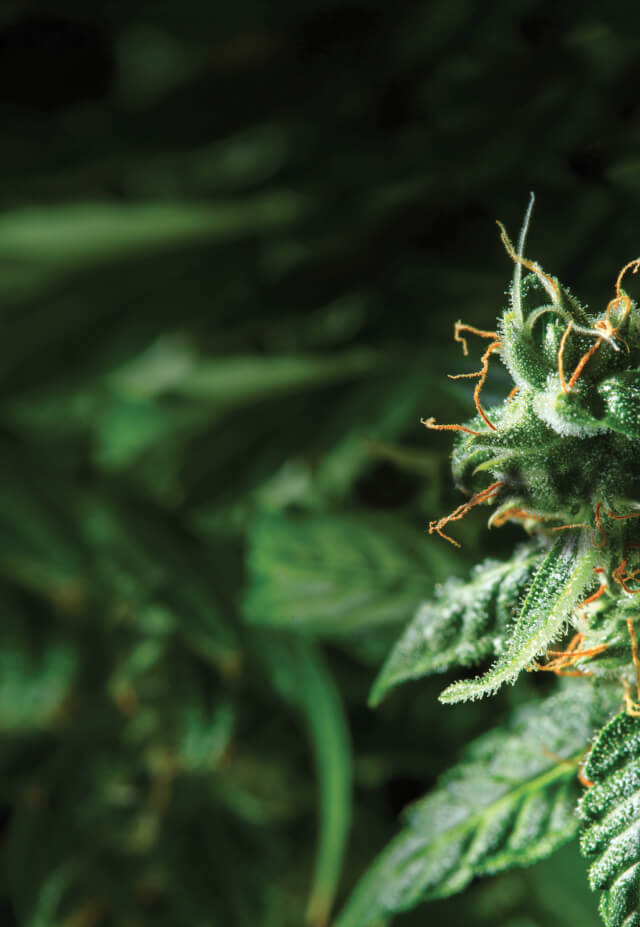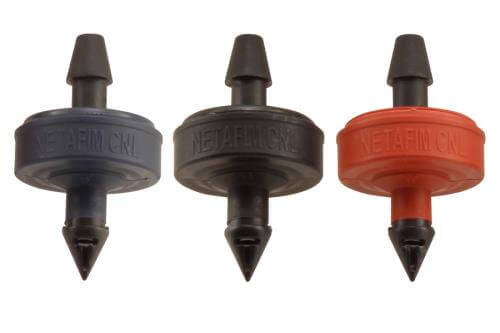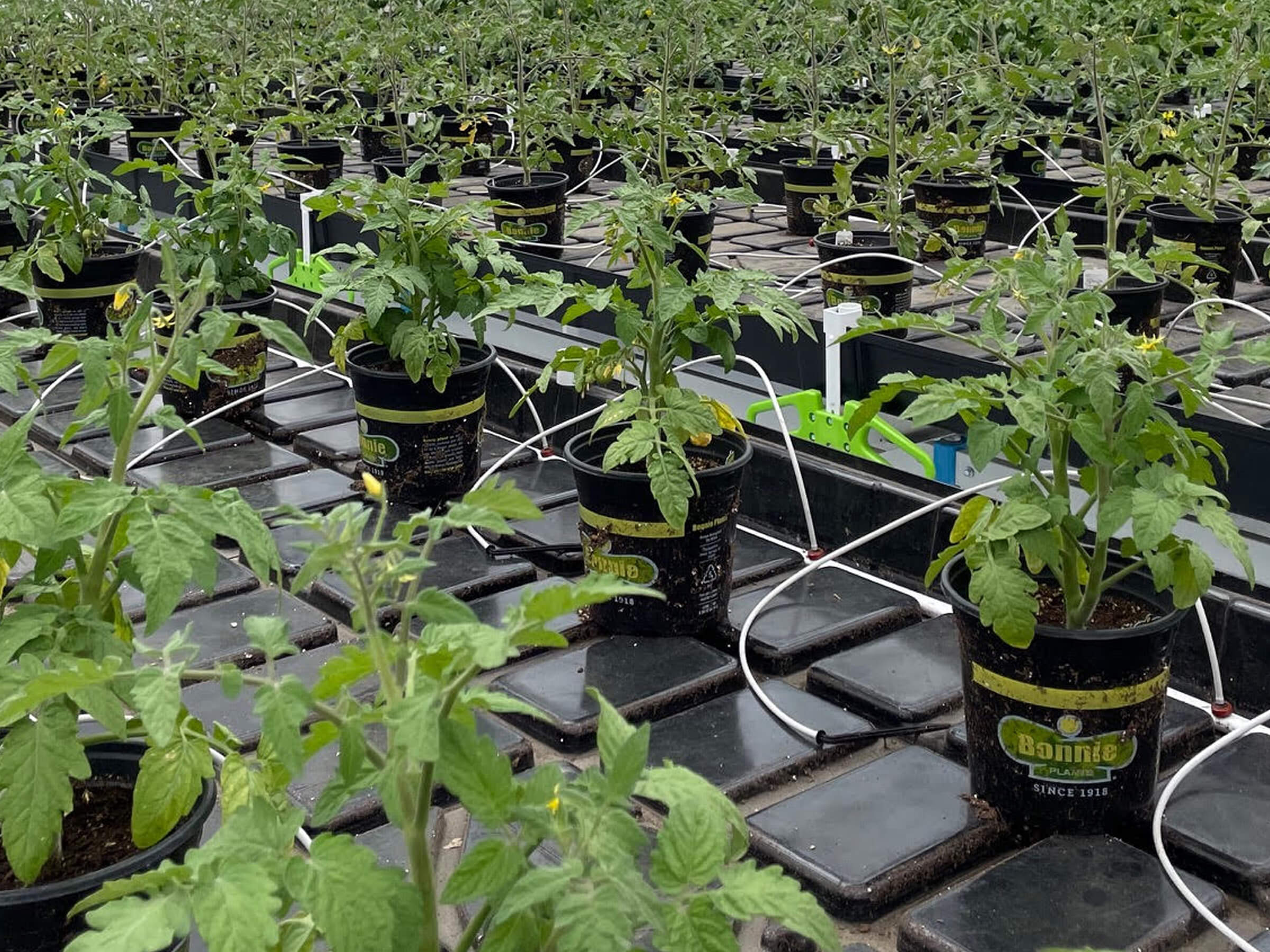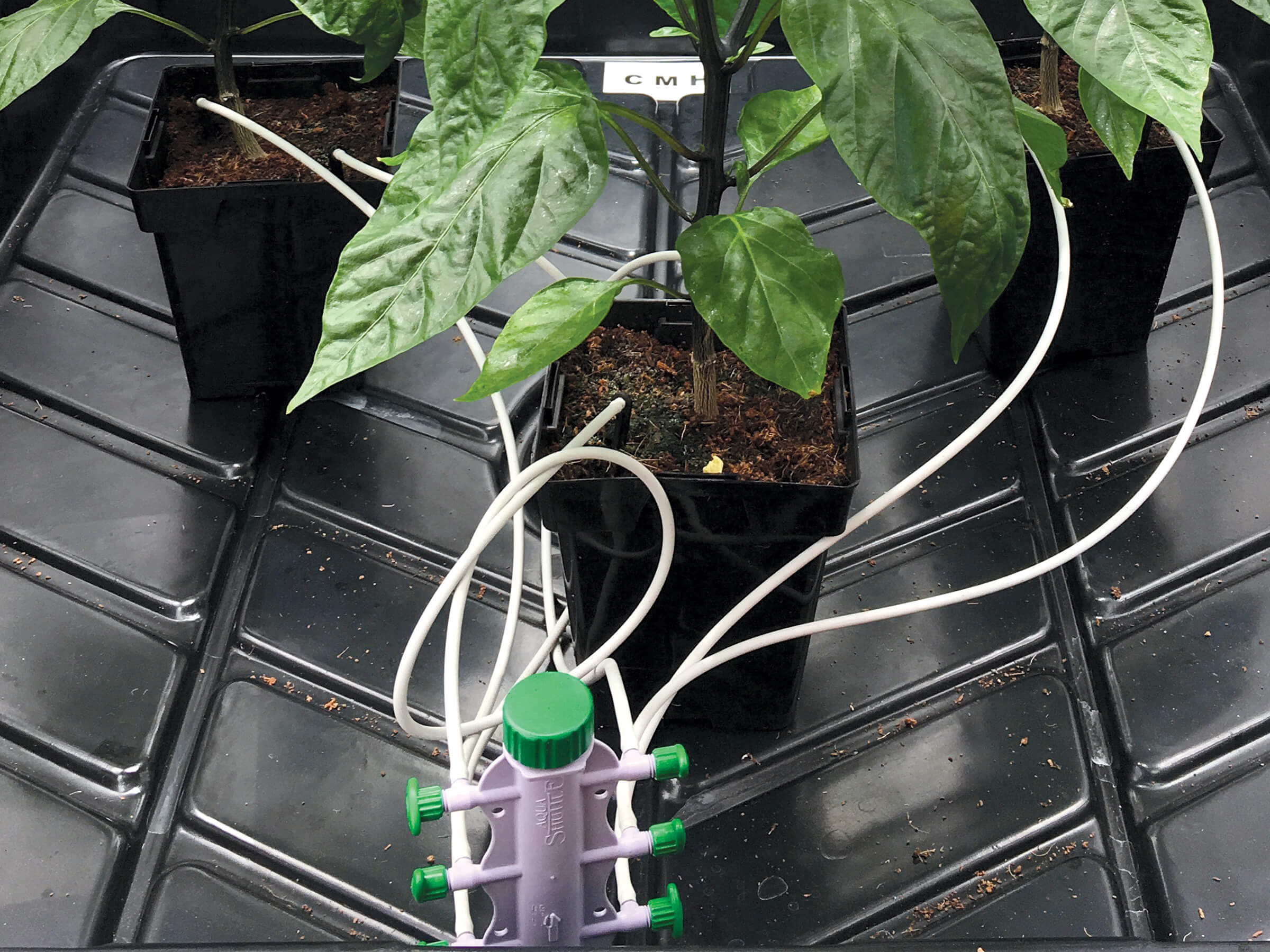Why drip irrigation vs. hand watering
With drip irrigation, gone are the days of trailing huge, kinking garden hoses and counting the seconds you water each plant, dousing each in water while fighting an unwieldy wand.
Thanks to drip irrigation, there’s no need to dump a ton of water onto a plant all at once, because there’s no rush when you have a fully automated system.
What is a drip emitter?
Drip emitters control the flow of the nutrient solution. By restricting the flow rate (common flow rates are 0.5-6+ gallons per hour, see below for more details) this allows long, relatively thin stretches of tubing to supply hundreds of drippers all from one tube. This means hundreds of plants can all be evenly watered from one tube with a smaller diameter than a garden hose!
Consider your media
Designing with a plant-first mentality means starting at the roots, and the media they’re in. You’ll want to choose your equipment based on how quickly water and nutrients can move throughout your chosen substrate.
| Media | Drainage Rate | Ideal Flow Level |
| Stonewool or Rockwool™ cubes | Very Fast | Low |
| Coco coir | Moderate | Medium |
| Peat-based | Slow | High |
Understanding flow rates
Consider this next metaphor: Do you want to eat one giant meal each day, or would you rather have 3 meals, plus snacks, some sort of protein smoothie, and maybe a dessert? Most people would prefer the latter. Same goes for plants and water/nutrients! Irrigation Essentials: Basics, Biology and Best Practices for a deeper look at this concept (and metaphors about cars!).
Flow Rate:
The volume of solution, per unit of time, that is moving through a pipe, emitter, tube, or similar
Common Units:
• Gallons per Minute (GPM)
• Gallons per Hour (GPH)
• Liters per Minute (LPM)
• Liters per Hour (LPH)
This is why emitters are rated at such a low flow compared to hand watering. This also gives us two of the most important qualities of a drip irrigation system: accuracy and efficiency.
How drip irrigation can help ensure accurate and efficient nutrient delivery
Let’s say you have a new irrigation technician who accidentally hand-waters each plant for 15 seconds instead of 5. This small mistake can result in gallons of additional nutrient solution being fed to the crop, which will be wasted, running straight down the drain. However, with the low flow of precision irrigation, a few extra seconds of irrigating will result in a much smaller volume of water (and nutrients) from being consumed.
Example
Let’s say we have two growers: Grower A and Grower B.
Grower A hand waters, and just hired Technician A to water for him.
Technician A waters for 3 seconds instead of 2 seconds per plant, resulting in an additional 0.16 gallons of water per plant. In his 500 plant grow, Grower A is now flushing 83 gallons of water (and nutrients!) down the drain—at every watering event (assuming a watering wand with standard 10 gallons per minute flow).
Grower B, on the other hand, installed an irrigation system.
She hires Technician B to fiddle with the irrigation system. This tech decides to add 1 minute to each irrigation event. They have 6 irrigation events per day. This means they now irrigate for an additional 6 minutes per day, per plant. Assuming a 1.0 GPH flow, they will only have an additional 50 gallons being delivered to the crop (and flushed down the drain).
Even with a simple example like this, it’s clear to see drip irrigation is more precise, with a wider margin of error when it comes to timing than hand watering.
Choosing the right flow rate
When it comes to drip irrigation, “low and slow” is the mantra we need to learn and repeat..
| Media | Recommended Flow | Recommended Emitter GPHA |
| Stonewool or Rockwool™ cubes | Low | 0.3 or 0.5 Ex: Grodan |
| Coco coir | Medium | 0.5-2.0 (or higher in some cases) |
| Peat-based | High | 1.0-6.6 (or higher!) |
Note: You can choose to go with a lower flow than recommended. However, a flow that’s too high can increase the risk of an effect called “channeling,” or when water pushes its way through the media without being absorbed. If this happens, your valuable nutrients are going straight down the drain. Bad for your plants, and your budget.
Number of emitters
Knowing your pot size is important to determining how many drip emitters you’ll need. Drip emitters have a limit to how wide their wetting pattern is (10-20 cm diameter). The larger the pot, the more drippers required.
The Hawthorne Difference
Our team of technical experts can help not only with the specifics on setting up a drip irrigation system, but also with the holistic, complex interplay between irrigation and other areas of your grow, including nutrients, growing media, HVAC and lights. Our goal is to provide growers the information they need to make the right decisions for their facilities, the first time
The products and advice to keep you in the game
Hawthorne Gardening Company, in partnership with some of the largest irrigation equipment manufacturers in the world, is here to help you maximize your crop’s potential with the best irrigation management strategies and information available today.
Our dedicated team can assist you in every step of the way to ensure that your system will work exactly how it is supposed to from day one.
For more information, call Hawthorne at 888-808-4826 or fill out the form below.



